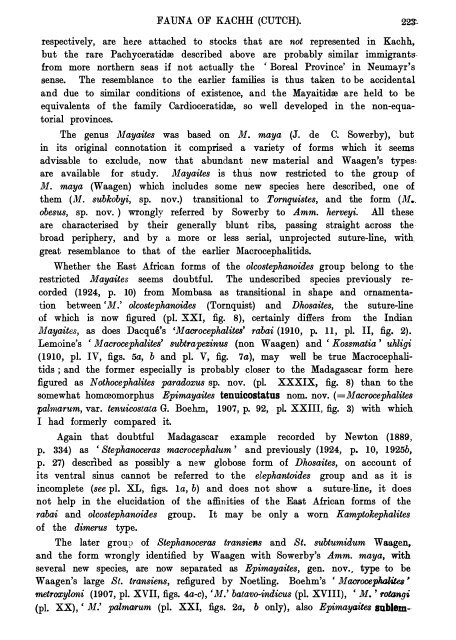ialontolngia ndita,
ialontolngia ndita,
ialontolngia ndita,
Create successful ePaper yourself
Turn your PDF publications into a flip-book with our unique Google optimized e-Paper software.
FAUNA OF KACHH (CUTCH).<br />
223:-<br />
respectively, are here attached to stocks that are not represented in Kachh,<br />
but the rare Pachyceratidre described above are probably similar immigrantsfrom<br />
more northern seas if not actually the 'Boreal Province' in Neumayr's<br />
sense. The resemblance to the earlier families is thus taken to be accidental<br />
and due to similar conditions of existence, and the Mayaitidre are held to be<br />
equivalents of the family Cardioceratidre, so well developed in the non-equatorial<br />
provinces.<br />
The genus Mayaites was based on M. maya (J. de C. Sowerby), but<br />
in its original connotation it comprised a variety of forms which it seems<br />
advisable to exclude, now that abundant new material and Waagen's types .<br />
are available for study. Mayaites is thus now restricted to the group of<br />
M. maya (Waagen) which includes some new species here described, one of<br />
them (M. subkobyi, sp. nov.) transitional to Tornquistes, and the form (M.<br />
obesus, sp. nov. ) wrongly referred by Sowerby to Amm. herveyi. All these<br />
are characterised by their generally blunt ribs, passing straight across the ·<br />
broad periphery, and by a more or less serial, unprojected suture-line, with<br />
great resemblance to that of the earlier Macrocephalitids.<br />
Whether the East African forms of the olcostephanoides group belong to the ·<br />
restricted .Z:layaites seems doubtful. The undescribed species previously re<br />
corded (1924, p. 10) from Mombasa as transitional in shape and ornamentation<br />
between 'M.' olcostephanoides (Tornquist) and Dhosaites, the suture-line<br />
of which is now figured (pl. XXI, fig. 8), certainly differs from the Indian<br />
JYJayaites, as does Dacque's 'Macrocephalites' rabai (1910, p. 11, pl. II, fig. 2).<br />
Lemoine's 'Macrocephalites' subtrapezinus (non Waagen) and 'Kossmatia ' uhligi<br />
(1910, pl. IV, figs. 5a, b and pl. V, fig. 7a}, may well be true Macrocephalitids<br />
; and the former especially is probably closer to the Madagascar form here<br />
figured as Nothocephalites paradoxus sp. nov. (pl. XXXIX, fig. 8) than to the<br />
somewhat homreomorphus Epimayaites tenuicostatus nom. nov. (=Macrocephalites<br />
palmarum, var. tenuicostata G. Boehm, 1907, p. 92, pl. XXIII, fig. 3) with which<br />
I had formerly compared it.<br />
Again that doubtful Madagascar example recorded by Newton (1889,<br />
p. 334) as 'Stephanoceras macrocephalum ' and previously (1924, p. 10, 1925b,<br />
p. 27) desciibed as possibly a new globose form of Dhosaites, on account of<br />
its ventral sinus cannot be referred to the elephantoides group and as it is<br />
incomplete (see pl. XL, figs. la, b) and does not show a suture-line, it does<br />
not help in the elucidation of the affinities of the East African forms of the<br />
rabai and olcostephanoides group. It may be only a worn Kamptokephalites<br />
of the dimerus type.<br />
The later group of Stephanoceras transiens and St. subtumidum W aagen,.<br />
and the form wrongly identified by Waagen with Sowerby's Amm. maya, with<br />
several new species, are now separated as Epimayaites, gen. nov., type to be<br />
Waagen's large St. transiens, refigured by Noetling. Boehm's 'Macrocephalites ,<br />
metroxyloni ( 1907, pl. XVII, figs. 4a-c), 'M.' batavo-indicus (pi. XVIII), ' M. ' rotangi<br />
(pl. XX}, ' M.' palmarum (pl. XXI, figs. 2a, b only), also Epimayaites sublem
















